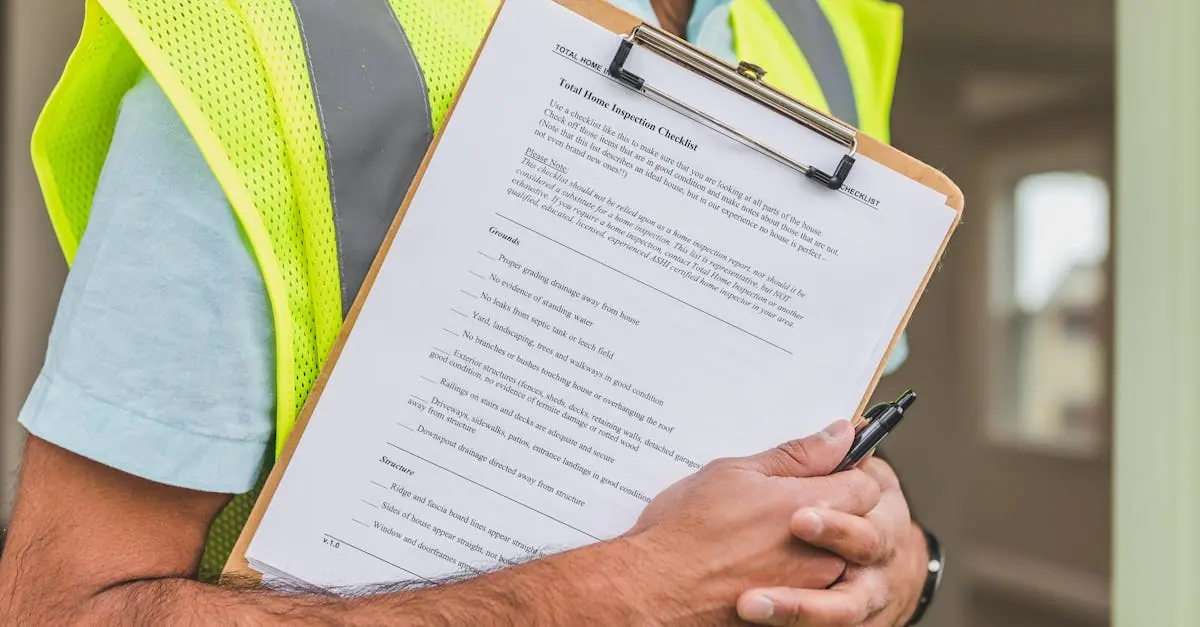A chainsaw is a powerful tool that can turn a daunting task into a walk in the park—if it’s running smoothly, that is. But neglect it, and it might just turn into a noisy paperweight that tests your patience and your sanity. To keep your trusty saw from becoming a drama queen, a solid maintenance checklist is essential.
Think of it as a spa day for your chainsaw. With a little TLC, it’ll purr like a kitten instead of roaring like a lion. Regular check-ups not only extend its lifespan but also ensure it performs at its best when you need it most. So grab your favorite wrench and let’s dive into the must-have maintenance tips that’ll keep your chainsaw ready to tackle any woodpile—or surprise tree limb—life throws your way.
Table of Contents
ToggleImportance Of Chainsaw Maintenance
Maintaining a chainsaw is essential for optimal performance during use. Regular upkeep prevents wear and tear, ensuring that the tool operates efficiently. Safety becomes paramount when chainsaws function correctly. Neglected equipment can lead to accidents or injuries due to malfunction.
The efficiency of the chainsaw depends on consistent maintenance practices. Checking the chain tension helps prevent damage to both the chain and the saw. Users maintain the sharpness of the chain to achieve cleaner cuts, reducing overall effort. Keeping the air filter clean promotes proper airflow, which enhances engine performance.
Improper maintenance could result in decreased fuel efficiency. Chainsaws with dirty spark plugs may struggle to start, wasting time and effort. Inspecting the fuel system regularly prevents clogs that can halt operation.
Users can also benefit from cleaning the guide bar and sprocket regularly. Removing debris ensures smooth chain movement, which decreases friction and wear. Scheduled lubrication of moving parts mitigates potential issues, extending the life of the tool.
Overall, prioritizing chainsaw maintenance translates into improved performance and reliability. Regular inspections and adherence to a maintenance checklist foster a safer and more effective working environment. By treating the chainsaw with care, users can tackle various tasks with confidence, knowing their tool is in prime condition.
Essential Tools For Maintenance
Proper tools make chainsaw maintenance straightforward. Having the right equipment at hand simplifies the process and enhances the performance of the tool.
Basic Tools Required
Basic tools are essential for any chainsaw maintenance routine. A screwdriver set assists in adjusting screws on the chainsaw. A wrench helps tighten or loosen bolts effectively. Utility gloves provide hand protection during service. A screnching tool allows for easier chain adjustments. Chain oil ensures ample lubrication for smooth operation. Using these basic tools promotes efficiency in maintaining the chainsaw.
Additional Tools For Advanced Care
Advanced care requires additional tools for comprehensive maintenance. A chainsaw file is crucial for sharpening the chain teeth. A depth gauge assists in measuring chain depth for optimal cuts. A brush helps clear debris from the air filter and cooling fins. Pliers aid in removing small debris caught in moving parts. A tachometer can measure engine speed to improve performance. Utilizing these advanced tools ensures thorough care for prolonged chainsaw efficiency.
Chainsaw Maintenance Checklist
Maintaining a chainsaw ensures optimal performance and safety. Regular upkeep extends its life and enhances cutting efficiency.
Daily Maintenance Tasks
Daily inspections keep a chainsaw performing at its best. Check the chain tension before each use; proper tension prevents slippage and promotes safety. Sharpen the chain as needed for cleaner cuts, especially after heavy usage. Inspect the air filter daily, ensuring it stays clear of debris to enhance engine performance. Ensure the fuel mixture meets manufacturer specifications to avoid starting problems. Clean the guide bar and sprocket after each use, removing wood chips and dirt to prevent wear.
Weekly Maintenance Tasks
Every week, it’s essential to conduct more thorough maintenance tasks. Inspect the entire chainsaw body for signs of wear, including cracks or damage. Clean the chain brake to ensure reliable performance during operation. Oil the chain and guide bar before use to minimize friction and extend their lifespan. Check the spark plug for wear and clean it as necessary; a healthy spark plug enhances engine efficiency. Verify the functionality of safety features, including the chain brake and throttle lock, ensuring they operate correctly.
Monthly Maintenance Tasks
Monthly maintenance tasks dig deeper into the chainsaw’s overall health. Perform a complete chain sharpness check; use a chainsaw file for proper sharpening to maintain cutting effectiveness. Remove the air filter, giving it a thorough clean or replacement if needed. Inspect the fuel lines and connections for leaks or cracks, which can lead to fuel efficiency issues. Replace the spark plug based on wear and tear to maintain optimal ignition. Finally, check all bolts and screws, tightening any loose components to ensure the chainsaw operates smoothly.
Troubleshooting Common Issues
Maintaining a chainsaw involves recognizing and resolving performance issues promptly. Awareness of common problems can enhance the overall effectiveness of the tool.
Identifying Performance Problems
Users may notice various performance problems, such as difficulty in starting the engine. A clogged air filter frequently causes stalling or poor acceleration. Inconsistent chain movement often points to insufficient lubrication. Reduced cutting efficiency can indicate a dull chain, while excessive vibration generally suggests a misaligned guide bar. Observing these symptoms helps in diagnosing underlying issues, ensuring maintenance keeps the chainsaw functioning optimally.
Solutions For Common Issues
Addressing starting issues typically involves cleaning or replacing the air filter. Chainsaw users should always sharpen the chain for improved cutting performance. Lubricating the guide bar and chain ensures smooth operation, reducing wear. For vibration problems, realigning the guide bar and checking chain tension often solves the issue. Regularly inspecting the spark plug and replacing it as needed prevents engine performance drops. Implementing these solutions significantly extends the lifespan of the chainsaw and enhances safety during use.
Conclusion
Maintaining a chainsaw is crucial for optimal performance and safety. By following a structured maintenance checklist and using the right tools, users can prevent common issues and extend the lifespan of their equipment. Regular attention to tasks like chain tension, sharpness, and air filter cleanliness ensures the chainsaw operates smoothly and efficiently.
Addressing minor problems early on can save time and money in the long run. A well-maintained chainsaw not only enhances cutting performance but also promotes a safer working environment. By prioritizing these maintenance practices, users can confidently tackle their projects, knowing their chainsaw is in excellent condition.








